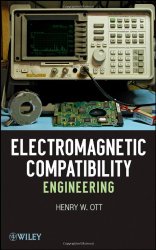Engineering Bookshelf
- Aerospace
- Biological
- Civil
- Chemical
- Environmental
- Electrical
- Materials
- Mechanical
- Petroleum
- Geoengineering
- Software

Electromagnetic Compatibility Engineering
by Henry W. OttPublisher: Wiley
ISBN: 0470189304
Check price @ amazon.com , amazon.ca , amazon.co.uk
Book Description
Electromagnetic Compatibility Engineering is a completely revised, expanded, and updated version of Henry Ott's popular book Noise Reduction Techniques in Electronic Systems. It reflects the most recent developments in the field of electromagnetic compatibility (EMC) and noise reduction¿and their practical applications to the design of analog and digital circuits in computer, home entertainment, medical, telecom, industrial process control, and automotive equipment, as well as military and aerospace systems.
While maintaining and updating the core information—such as cabling, grounding, filtering, shielding, digital circuit grounding and layout, and ESD—that made the previous book such a wide success, this new book includes additional coverage of:
- Equipment/systems grounding
- Switching power supplies and variable-speed motor drives
- Digital circuit power distribution and decoupling
- PCB layout and stack-up
- Mixed-signal PCB layout
- RF and transient immunity
- Power line disturbances
- Precompliance EMC measurements
- New appendices on dipole antennae, the theory of partial inductance, and the ten most common EMC problems
The concepts presented are applicable to analog and digital circuits operating from below audio frequencies to those in the GHz range. Throughout the book, an emphasis is placed on cost-effective EMC designs, with the amount and complexity of mathematics kept to the strictest minimum.
Complemented with over 250 problems with answers, Electromagnetic Compatibility Engineering equips readers with the knowledge needed to design electronic equipment that is compatible with the electromagnetic environment and compliant with national and international EMC regulations. It is an essential resource for practicing engineers who face EMC and regulatory compliance issues and an ideal textbook for EE courses at the advanced undergraduate and graduate levels.
About the Author
Henry W. Ott is President and Principal Consultant of Henry Ott Consultants (www.hottconsultants.com), an Electromagnetic Compatibility (EMC) training and consulting organization located in Livingston, NJ. Mr. Ott has over thirty years experience in the field of EMC. Prior to starting his own consulting company, he was with AT&T Bell Laboratories for thirty years, where he was a Distinguished Member of the Technical Staff.
Mr. Ott is a Life Fellow of the Institute of Electrical and Electronic Engineers (IEEE), and an Honorary Life Member of the IEEE EMC Society. For over twenty years, Mr. Ott served the IEEE EMC Society in various capacities including; member of the Board of Directors, Education Committee Chairman, Symposium Committee Chairman, and Vice President for Conferences.
Customer Reviews
By B. Jacquot (New York)
This book nicely bridges the gap between theory and practice, providing a highly readable account of both. Helpfully, there are practice problems at the end of each chapter to test your understanding and solutions provided for all of them at the end of the book. I found this particularly useful for focusing attention in the very detailed middle chapters where I assume Ott picked the most important concepts for problems. The chapters flow coherently into one another and refer to each other, making the book more of a long, continuous discussion versus a bunch of discretely written texts thrown together in a book.
If you want to build up you intuition about applied electromagnetics and PCB design, this book is worth a very close read.
By C. Crome (California)
This is an absolutely fantastic resource for any electrical engineer, circuit designer, layout engineer, or EMC engineer. It lays out in detail and in very simple and easy to understand language how to design real products that need to pass FCC and CE regulations. It makes certain things that used to be mysterious crystal clear. Quite a comprehensive guide on all aspects of building real pcbs for EMC. A must have that belongs right alongside, "The Art of Electronics."
By Alanna C.
I have been working in the EMC area for roughly a year now, and I found myself wanting to understand the "why" of what the various Standards represent - applying a standard is one thing, but knowing why you are doing what you are creates opportunity to troubleshoot faster but also involves personal growth in a field of unique demand (aka leverage). Also - I thought it was easy to read. I have a background in antenna theory and electromagnetics, and have been performing EMC testing on equipment - which I believe made this a very straight forward read - but if you don't have that background - that's okay! There is Part 2 in the book that takes the time to explain the theory (in a straight forward manner) so that a with general interest/knowledge can also gain something from the conversations.